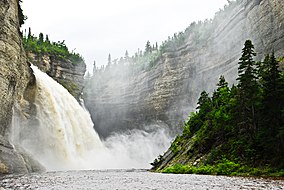Anticosti National Park (French (official): Parc National d'Anticosti) is a provincial park of Quebec, located in the Gulf of St. Lawrence.[2][3] It consists of 3 non-contiguous areas totalling 572 square kilometres (221 sq mi) of land in the centre of Anticosti Island. Portions of the park are within Anticosti World Heritage site.
| Anticosti National Park | |
|---|---|
| Parc National d'Anticosti | |
 Cliff wall, fall and Vauréal River[1] | |
| Location | Quebec, Canada |
| Nearest city | Port-Menier, Quebec |
| Coordinates | 49°30′N 62°50′W / 49.500°N 62.833°W |
| Area | 571.9 km2 (220.8 sq mi) |
| Established | April 2001 |
| Visitors | 5500 (in 2009) |
| Governing body | Sépaq |
| www | |
 | |
Tourism
editIt is organized into 6 tourist sectors and 1 central zone:[4]
- Baie-de-la-Tour
- Chicotte
- Chute-Vauréal
- Grotte-à-la-Patate
- Observation
- Vauréal-la-Mer
- Zone centrale
History
editThe idea of creating a park on Anticosti Island goes far back. Already in the 1920s, the richness of Anticosti's flora was highlighted by botanist Marie-Victorin, who described the canyon of the Vauréal River as a "remarkable sanctuary" for ferns. But for the following decades, the entire island was privately owned by a succession of logging companies who invested little or nothing in environmental protection.[5][6]
In 1974, Anticosti Island was bought by the Government of Quebec and became public land once again. In 1987, the Regional County Municipality of Minganie officially incorporated the idea of creating a park in the Vauréal River area in its development plan. Thereafter, it took 14 years to complete the research, studies, planning, and public hearings. The Quebec government created "Anticosti National Park" on April 26, 2001.[5] Despite its name, it is a provincial park, and not part of the country's national park system.
Park features
editNatural attractions:[4]
- Vauréal Canyon and Waterfall - At the Vauréal Waterfall, the Vauréal River drops 76 metres (249 ft) and then flows through a 90 metres (300 ft) deep gorge.
- Tour Bay (Bay de la Tour) - This bay on the north side of the island is noteworthy for its breathtaking seascape with huge cliffs surrounding the bay and excellent bird watching opportunities.
- Potato Cave (Grotte à la Patate) - This 625 metres (2,051 ft) cave is one of the longest caves in Quebec. It is named after the Potato River (Rivière à la Patate) which gets its name from a large granite erratic boulder shaped like a potato that is located at the river's mouth.
- Brick River Canyon
- Observation River Canyon
Activities:
- Hiking - 45 kilometres (28 mi) of trails of various difficulty
- Horseback riding
- Sea kayaking
- Guided tours
Park amenities:
- 2 Visitor centres with restaurant, gasoline, and equipment rental
- Accommodation in inns, cabins, or campgrounds
- Picnic areas
UNESCO's World Heritage
editOn September 19, 2023, Anticosti was inscribed on UNESCO's World Heritage List. It is recognized for its exceptional fossil assemblage representing the first global mass extinction of animal life on Earth.[7]
Located within protected areas[3] free from any industrial activity, the site is endowed with exceptionally well-preserved, abundant and diverse fossil fauna. This Anticosti fauna represents the first mass extinction of animal life on a global scale, 447 – 437 million years ago, at the end of the Ordovician period.[8]
- Vauréal Canyon
-
Cliff wall, fall and Vauréal River[1]
-
Fossil (probably sponge), in the gravel, at the foot of the wall
-
Fossil to be identified, in the gravel, at the foot of the wall
The Vauréal River, with its source in Lake Vauréal, flows 25 km, south then northeast, in the eastern part of the island. The salmon go up the river to the Vauréal Falls, 13 km from the coast, crossing the Vauréal canyon where the river is enclosed between two limestone walls.[9][1]
References
edit- ^ a b c "Vauréal canyon". Commission de toponymie Quebec (in French). Commission de Toponymy Quebec. 1984-10-04. Retrieved 29 July 2024.
... 3 kilometer canyon, whose walls can reach more than 90 meters in height
- ^ "Protected areas in Quebec" (in French). Ministère de l'Environnement, de la Lutte contre les changements climatiques, de la Faune et des Parcs. 2024. Retrieved 13 August 2024.
Protected areas are also recognized as an essential tool for adaptation to climate change. In particular, they allow carbon to be stored.
- ^ a b "Map of protected areas in Quebec" (PDF) (in French). Environment and Climate Change Canada. March 2024. Retrieved 13 August 2024.
Protected areas register database, 2024 Ministry of Environment and Ecological reference framework, 2018 adapted
- ^ a b Parc national d'Anticosti - Park Journal 2008-2009 Edition, Parcs Québec
- ^ a b "Portrait du parc - Histoire de la création du parc national d'Anticosti" (in French). Sépaq. Retrieved 2009-11-10.
- ^ "Histoire d'Anticosti" (in French). Municipalité de L'Île-d'Anticosti. Archived from the original on 2010-05-05. Retrieved 2009-11-10.
- ^ "Anticosti inscribed on UNESCO's World Heritage List". Parks Canada. September 19, 2023. Retrieved 28 February 2024.
There are currently more than 1,440 known fossil species on Anticosti Island
- ^ "Anticosti". UNESCO World Heritage Convention. 2023. Retrieved 28 February 2024.
Anticosti is the best natural laboratory in the world for the study of fossils and sedimentary strata from the first mass extinction of life at the end of the Ordovician period
- ^ "Vauréal River". Quebec Gouvernement (in French). Commission de Toponymy Quebec. 1968-12-05. Retrieved 29 July 2024.
Originally, it was known under the name Morsal or Maujerol in memory of a French Huguenot from Avignon.
